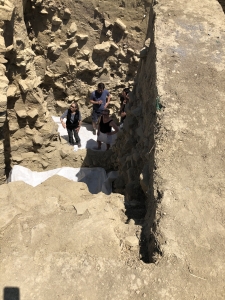
For ten days this summer I was in Athens with Professor Sheila Dillon and her research team in the Athenian Agora. Professor Dillon’s research focuses on portrait statuary in the Agora, and she also leads the Digital Athens project in the Wired! Lab. I was a member of this project during my last two years at Duke, working with a GIS (geographic information system) software product, ArcGIS, to visualize the changes in Ancient Athens by digitizing and georeferencing maps and plans, plotting material remains found in excavations, and researching the locations of various workshops in the Agora. This summer, I continued this work, georeferencing ancient and modern plans of the area around the Library of Pantainos in the Agora and researching sculpture find spots using ArcGIS and excavation journals from that area.

In addition to seeing sites in Athens such as the National Archaeological Museum and Epigraphical Museum, I traveled with Professor Dillon and the rest of her team to several other cities in Greece during the course of this trip. We visited the archaeological sites at Patras, Olympia, Pylos, Messini, and Corinth. I learned a great deal about archaeology, excavation, history and art history by visiting these sites, and they provided insights into Professor Dillon and her team’s portraiture research. There were many highlights to the trip, including a visit to the ongoing excavation of tholos tombs at Pylos where we were able to talk to the archaeologists, go into their trenches, and see their cleaning and storage methods. Likewise, we got behind-the-scenes access at Corinth where we were able to look through shelves upon shelves of material for statuary remains.

I spent the majority of my undergraduate experience studying classical philology, but this trip truly reinforced for me the important place that archaeology and art history have in classics. Being in Greece allowed me to situate myself in the historical and topographical context of Ancient Greece, leaving me much more informed and excited about this field.
This trip was made possible thanks in large part to the Duke Classics department and the Leonard and Lynn Quigley Fund. I had an excellent trip and am very grateful to have had this opportunity.